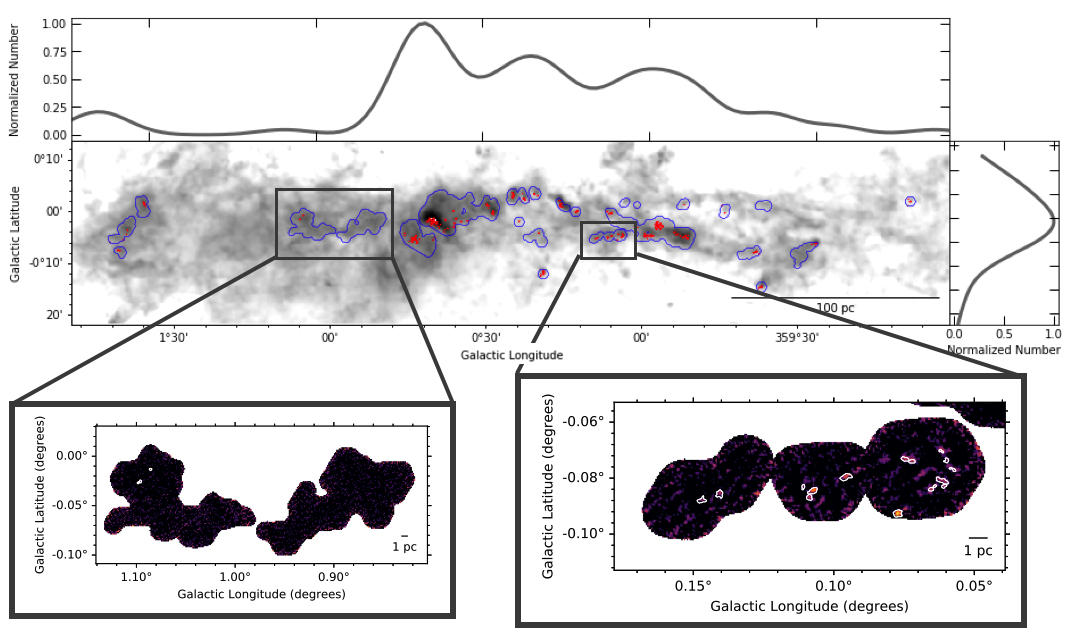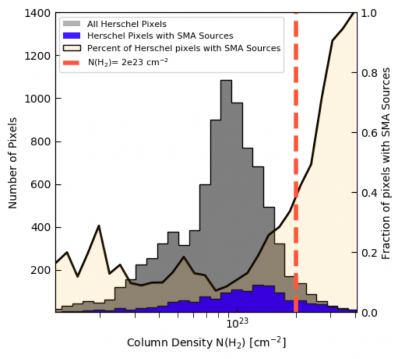The CMZoom Catalog Paper is published! 🤩🥳 Read the full paper on ADS here: https://ui.adsabs.harvard.edu/abs/2020ApJS..251…14H/abstract. The related data and catalogs can be downloaded on our dataverse page: https://dataverse.harvard.edu/dataverse/cmzoom
Well done H Perry Hatchfield! Read a summary of the paper, by H Perry below:
The Milky Way’s central region (the central molecular zone or CMZ) contains a modern astrophysical enigma. Despite its impressive reservoir of fuel for star formation, hosting 80% of all the high density gas in the Milky Way, the CMZ appears to be forming far fewer stars than we would expect. The CMZoom survey was designed to take a complete look at the high density clouds of the CMZ and to generate a catalog of as many sites of possible high mass star formation as possible to help us understand how stars form in this extreme environment.
The CMZoom survey uses the Submillimeter Array to map all material in the CMZ above a column density of 1023 cm-2, an unprecedented broad look at this anomalous environment. In this paper, we use CMZoom’s 1.3mm dust continuum emission to catalog the compact substructure within the surveyed region. We construct the dust continuum catalog using a pruned dendrogram algorithm, a hierarchical clustering method that produces a “tree” of related sources, with the highest level emission being the “leaves”. This tree of sources is “pruned” by removing leaves that are not sufficiently significant relative to the local noise level. Figure 1 shows the distributions of these dendrogram leaves from the robust version of the catalog, along with zoom-ins of two sample regions. Figure 2 shows a histogram of the Herschel column densities at which SMA sources are found, a distribution with a sharp uptick around 1-2×1023 cm-2. This sudden increase in compact structure may support the existence of an environmentally variable density threshold for gravitational collapse and star formation.
While the catalog does not investigate which of these objects host signatures of star formation, we plan to investigate their properties further in future work. By simulating interferometric observations, we find the catalog is complete to >99% of places where a massive star (M>8M⊙) could form. Considering all these possible sites of star formation, this catalog reveals the CMZ to be extreme in its variety of dense gas morphology, with many extremely dense clouds exhibiting little to no compact substructure, while nearby regions are overflowing with sites of ongoing and future star formation.

Fig 1. A column density map from Herschel with overlaid blue contours representing the CMZoom SMA footprint, and identified sources overplotted in red. A kernel density estimation is shown for the galactic longitude and latitude, representing the normalized distribution of the robust catalog’s sources. The highest concentration of sources is in the Sgr B2 complex, the Dust Ridge, and the 50 km s-1 cloud, while many regions are devoid of compact substructure despite their high column densities. The two zoom-in panels show the 1.1 Degree Cloud Complex (left), which displays very little substructure, and the Three Little Pigs (right), which are named for their seemingly sequential increase in substructure complexity. The catalog sources are shown as white contours on top of the SMA 1.3mm dust continuum.

Fig 2. The column density distribution of Herschel pixels that correspond to an SMA 1.3mm dust continuum source from the CMZoom robust catalog. The grey histogram represents the column density of all Herschel pixels within the CMZoom footprint, and the blue histogram represents the subset of these which house a robust catalog source. The black line is the fraction of Herschel pixels at each column density bin which have CMZoom sources. This fraction increases sharply past a column density threshold of 1-2×1023 cm-2, suggesting that compact substructure is more readily able to condense and persist at these high column densities.